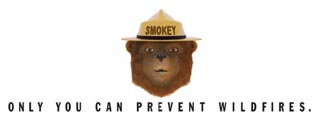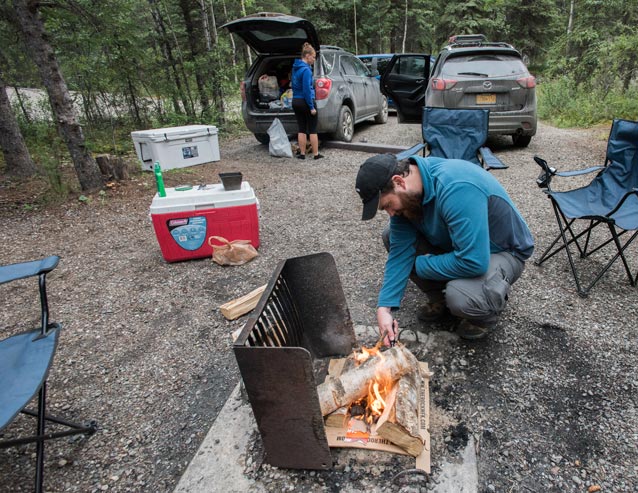When When the Fire s at My Feet Again
Campfires

U.South. Woods Service
Whether yous grew upwards making lawn blazes or yous're about to build your first fire ever, this overview of campfires will assist you accept a great time. Yous'll find recommendations for how to safely build, feed and extinguish a campfire.
You can find even more info and videos from the U.Due south. Forest Service and Smokey Bear.

NPS Photo / Kent Miller
Safety First
Having an open burn is often a key and enjoyable part of camping. The smell of woodsmoke and the pop and hiss of burning woods in a campfire brightens any night out in the woods, mountains, or beach.
All the same, you want to brand sure you command your fire, and non the other way around!
Before starting your fire, follow these steps:
- Know the local rules
Each park has their ain rules on where and when you can have a campfire. Ask at the visitor center or contact the park before you lot visit so you know any relevant rules. - Know the fire conditions
Has it been windy and dry lately? That might hateful campfires are banned, or that other special rules or restrictions are in consequence. Over again, contact the park when you arrive or presently before you lot visit to find out if there is a burn ban or other weather-related rules y'all need to know.
Kinds of Fires
Not all campfires are the same! For some people, the thought of a campfire is 2 logs quietly burning in a fire ring, while for others, the aforementioned discussion means a four-foot tall blazing pile of wood and castor.
Different parks let different sizes and types of fires. Don't assume a bonfire is going to be ok in a busy campground full of kids, RVs and copse. Ask at the visitor centre or find the campground host to come across if specific areas are set aside for fires, and if there are rules on the size of your blaze.
Making a Burn
Before starting your bivouac, take a await around your campsite to brand sure your tent, gear, and any other combustible objects are at least 15 feet abroad and upwind of the firepit.
- Buying or using local kindling/woods
Kindling and forest should be bought near the campground (or collected from the surface area, if the rules let doing that - keep in listen, this is non allowed in many national parks). Bringing woods from far away might also bring along pests that volition flee your burning wood and potentially invade and cause problems in their new surroundings. - Constructing your burn
There are many means to arrange your firewood earlier you first called-for.Fire needs air to grow, so don't merely stack your wood in a dense pile. One way to get-go is by laying larger pieces of wood in a cross-hatch pattern, making a small tower. Then, place plenty of kindling (e.g. dried leaves, pocket-sized twigs, etc.) and firestarter (e.g., methane series-soaked cotton balls, shredded paper, etc) in the gaps between the wood.
Also remember that bark doesn't burn too every bit the rest of the forest, so chopping your wood into thinner pieces, to betrayal more than of the interior, will go your fire going faster.
Employ matches or a lighter on your firestarter to ignite it; it should and so catch your kindling on burn down, which should eventually catch your larger pieces of wood on fire.
- Using accelerants
An accelerant is an extremely flammable liquid or mixture, like lighter fluid, that is used to speed up starting a fire. Use merely lighter fluid to start a campfire. Never use any other accelerants, like gasoline, as this tin be super unsafe to you and others around you! Also, practice not eject lighter fluid onto embers or open up flames, as this may pb to a quick flare upward and crusade peel burns. When y'all stop at the company center, check to make sure it's ok to apply chemical accelerants, similar lighter fluid. - Keeping the fire burning
Your fire might burn quite quickly if your firewood is extremely dry out. Wetter forest volition burn slower, but you lot don't want information technology too moisture or it won't grab burn down. Moisture wood volition smoke fashion more than dry wood. If you have actress firewood, keep it stacked upwind of your fire, so that a sudden breeze won't light all the rest of your wood on fire. Keep the fire minor so it stays nether control.
Prophylactic Second: One time You Accept the Fire Burning
You want to think about safety before starting a burn down and you should keep it in mind while the fire is going, besides.
- Shut plenty to toast marshmallows, non easily
Depending on the size of your fire and how windy it is, you might exist able to sit right by it - or you might have to stand up several feet away. Remember that synthetic clothing melts when it gets hot - don't ruin your nice new fleece jacket past letting sparks accident on it from your campfire! If yous plan on cooking on the fire, make certain you have cooking tools that are long enough and so you accept a safe distance between you lot and the fire. Look for cooking tools with insulated handles to avoid burns. - Watch children and pets around campfires
It almost goes without saying, simply if you're camping ground with kids or pets, keep an eye on them. Young children who oasis't been around a campfire before might not be cautious well-nigh running near it. - Drinking and called-for
If the campground where you're staying allows alcoholic beverages, exercise not throw bottles or cans into the burn down! Broken glass and half-melted aluminum volition probably make the next camper pretty unhappy. Burning anything but forest (especially plastics) can too pb to toxic gases.Too keep in heed that your campground is a public infinite, and public intoxication is generally illegal, in addition to beingness pretty unsafe when yous're tending to an open up fire.
Safety Tertiary: Preparing for Emergencies
Never exit a campfire unattended. Ever keep h2o nearby when you have a campfire. You lot might have a sudden need to put it out or the atmospheric condition might alter dramatically (such as the wind might grow really informal and threaten to push button your burn out of your fire ring). Know what steps to accept if someone is burned past sparks, hot cooking tools, or dress-down. Don't forget to "finish, drop, and roll" if whatsoever of your clothes catch on fire.
If your fire gets out of control, note your location and phone call 911 for assistance. If in that location is no cell service, contact the nearest park ranger or campground host to report the fire.
Putting Out Your Burn down
All good things come up to an end but if your campfire is also hot to touch, don't leave or become to sleep. Whitish or grey coals can retain heat for hours and hours - and can flare up if the wind starts gusting. And so, even if you have no more open flames, spread out your coals as best yous can.
- If yous take water available
Be sure to douse your burn down and dress-down with plenty of water when you lot're ready to call it a night. - If yous have no water
In a compression, utilise sand and dirt. However, don't merely kick sand or dirt on your burn - sometimes that can insulate or "banking company" the coals, keeping them hot fifty-fifty longer than if they remained exposed. Spread the coals out with a poker or other device, so continually stir dirt and sand among the coals until they extinguish.
Final updated: Apr 17, 2017
richardsonnourn1986.blogspot.com
Source: https://www.nps.gov/articles/campfires.htm
0 Response to "When When the Fire s at My Feet Again"
Post a Comment